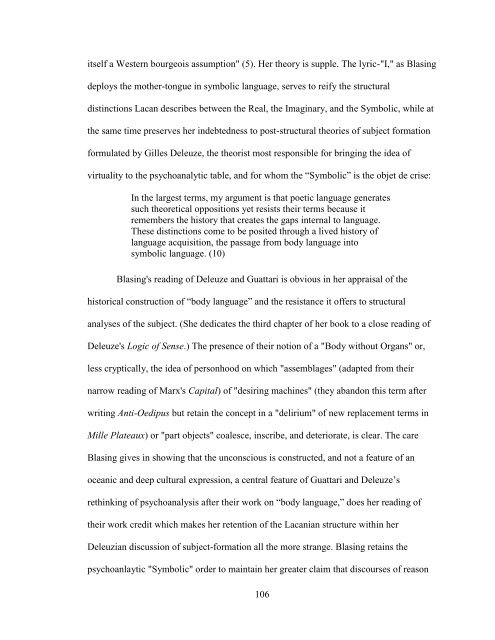TABOO: THE ACTUAL MODERNIST AESTHETIC, MADE REAL A ...
TABOO: THE ACTUAL MODERNIST AESTHETIC, MADE REAL A ...
TABOO: THE ACTUAL MODERNIST AESTHETIC, MADE REAL A ...
Create successful ePaper yourself
Turn your PDF publications into a flip-book with our unique Google optimized e-Paper software.
itself a Western bourgeois assumption" (5). Her theory is supple. The lyric-"I," as Blasing<br />
deploys the mother-tongue in symbolic language, serves to reify the structural<br />
distinctions Lacan describes between the Real, the Imaginary, and the Symbolic, while at<br />
the same time preserves her indebtedness to post-structural theories of subject formation<br />
formulated by Gilles Deleuze, the theorist most responsible for bringing the idea of<br />
virtuality to the psychoanalytic table, and for whom the ―Symbolic‖ is the objet de crise:<br />
In the largest terms, my argument is that poetic language generates<br />
such theoretical oppositions yet resists their terms because it<br />
remembers the history that creates the gaps internal to language.<br />
These distinctions come to be posited through a lived history of<br />
language acquisition, the passage from body language into<br />
symbolic language. (10)<br />
Blasing's reading of Deleuze and Guattari is obvious in her appraisal of the<br />
historical construction of ―body language‖ and the resistance it offers to structural<br />
analyses of the subject. (She dedicates the third chapter of her book to a close reading of<br />
Deleuze's Logic of Sense.) The presence of their notion of a "Body without Organs" or,<br />
less cryptically, the idea of personhood on which "assemblages" (adapted from their<br />
narrow reading of Marx's Capital) of "desiring machines" (they abandon this term after<br />
writing Anti-Oedipus but retain the concept in a "delirium" of new replacement terms in<br />
Mille Plateaux) or "part objects" coalesce, inscribe, and deteriorate, is clear. The care<br />
Blasing gives in showing that the unconscious is constructed, and not a feature of an<br />
oceanic and deep cultural expression, a central feature of Guattari and Deleuze‘s<br />
rethinking of psychoanalysis after their work on ―body language,‖ does her reading of<br />
their work credit which makes her retention of the Lacanian structure within her<br />
Deleuzian discussion of subject-formation all the more strange. Blasing retains the<br />
psychoanlaytic "Symbolic" order to maintain her greater claim that discourses of reason<br />
106
















